Now that I’ve had a chance to play with Battles in limited and constructed, I’m a huge fan of the card type. Basically, I think battles are what planeswalkers wanted to be, at least for game play.
I believe there were two main goals when planeswalkers were introduced to the game. The first is to create iconic cards which help build Magic’s IP and brand. Planeswalkers did that in a way battles couldn’t. The second is to make games take place on the battlefield rather than the stack, and encourage playing more creatures. Here, battles are a better execution.
The problem with Planeswalkers is they’re self-solving. You don’t need creatures to make planeswalkers good. You can use creatures to help defend your planeswalkers, but realistically, it’s a shaky proposition. If you play a creature, then a planeswalker, leaving your creature back so it can block, you’re presenting an opportunity to your opponent. If your opponent has a removal spell, they kill your would-be blocker and your planeswalker. By holding your creature back to defend a planeswalker, you missed out on an attack. It’s much safer to simply play removal to protect your planeswalker.
Planeswalkers make creatures better by giving them the hidden text “this can destroy planeswalkers.” But if planeswalkers are the stronger cards, then you don’t need to bother with creatures. I think this happened enough that it was clear that more answers to planeswalkers were needed, and now most removal spells can directly destroy planeswalkers. You don’t need creatures to defend planeswalkers or attack them. Now planeswalkers and creatures are basically interchangeable threats, except planeswalkers have the equivalent of haste or an enters the battlefield ability. Depending on how you want to think about it–they give you value up front, not all creatures do the same.
The other issue with planeswalkers is the way they run away with a game when they’re not answered, as they put your opponent further behind every turn you activate them. The experience of playing with planeswalkers is nothing new, and not the point I’m trying to make here.
With battles, the onus to play creatures is on the player who plays the battle, which makes sure that creatures are actually part of the equation. It makes deckbuilding an interesting calculation, in terms of how many creatures and how many battles you want to play. Also, when you spend mana casting a battle you’re not casting a creature, which makes it harder to win the battle. Your opponent can spend their mana that turn destroying your creature or playing another creature of their own.
Further, the payoff for a battle is fixed–once you’ve lost it, your opponent gets whatever prize was on the back and the game goes on. The prize is often something that helps attack you, like a creature, but your opponent functionally gave you some life in exchange for a creature at a good rate. If you can answer the creature, the life you got because they weren’t attacking you can give you some more time. This can let you recover from the advantage they got from the battle.
Battles create fun, tense minigames where you try to defend them. But, if you fail, you haven’t lost the game and you get an attempt at recovery.
Battles are “fixed planeswalkers” in that they should successfully lead to the kind of gameplay experience planeswalkers only barely delivered on.
However, I don’t think it’s a coincidence that battles came out now. I think battles are, in some way, a reaction to the weakness of planeswalkers in Commander.
Planeswalkers are generally much stronger in one-on-one games than in Commander, because you only have to defend them from one player. When anyone at the table is trying to decide who to attack, if there’s a planeswalker in play, they’ll probably attack that instead of a player. Most planeswalkers don’t stick around very long, which means most of them aren’t very good.
Planeswalkers are supposed to be exciting cards to open, but if Commander players are the primary audience for new cards, it’s very hard to make planeswalkers that really speak to them. Doing so will probably lead to commanders which are too strong in two player games.
With battles, we have the exact opposite experience, because you choose who defends the battle. In a four player game, you can usually find one player who isn’t equipped to do that, which makes it much easier for you to defeat your battles. Furthermore, you typically don’t care about dealing 3-7 damage in combat to a particular opponent in a game of commander, so there’s almost no opportunity cost to defeating them, unlike in two player games. This means battles naturally scale well for multiplayer, which is exactly what’s needed, since it’s so much harder for a card to break into Commander because it’s an eternal format.
So, acknowledging that this card type is great for Commander, which cards am I most excited for in the format?
My top 5 battles for Commander:
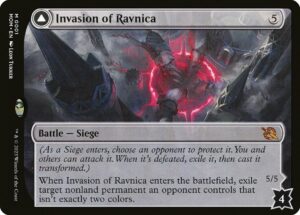
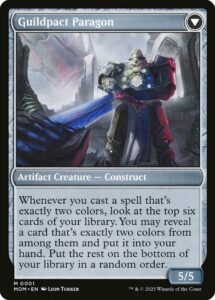
5: Invasion of Ravnica
This card is narrow; not a lot of decks are going to want it. Sorcery speed removal is pretty bad in Commander, but at least the front of this can answer a wide variety of permanents. It exiles, and you can get some decent value if you can flicker it. The bigger draw is the back. Most battles offer a mid-sized creature which doesn’t matter that much in a game of commander. This is the biggest problem with battles in the format. But here, the creature is kind of perfect. No one really wants to use a removal spell on it, and they don’t even know that it’ll really do much. But, if you build your deck to maximize it, it gives you a turbo-charged Recycle effect that lets all of your cards not just chain into more cards, but chain into more cards of your choice from multiple options. The deckbuilding cost is high, but the ceiling is incredible.
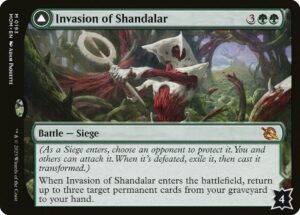
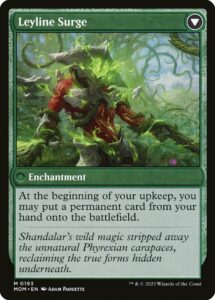
4: Invasion of Shandalar
I love graveyard recursion, but five mana to get three cards back from your graveyard isn’t a very good rate. However, while I think the front is more important than the back in two player games (especially in limited), in Commander, I think the back is the important part. Putting permanents directly onto the battlefield is great, not just because of the amount of mana it saves you, but because it bypasses the stack entirely. This means your opponents not only can’t counter what you put into play, but they can’t even respond to it. Once they know what it is, it’s already in play. That can be devastating
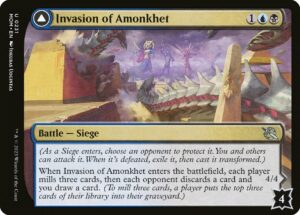
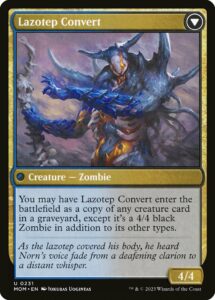
3: Invasion of Amonkhet
This card scales really well in multiplayer games, since it makes each player discard and mills each player. So you’re more likely to mill a powerful creature to copy with Lazotep Convert. Spending three mana without impacting the battlefield in casual commander isn’t much of a cost. The card wouldn’t be great without a back, but it wouldn’t be totally embarrassing if you had reasons to want cards in graveyards. But the real reason I like this is that while a lot of battles give you something unexciting on the back, this has the potential to copy something appropriately impactful for a game of Commander.
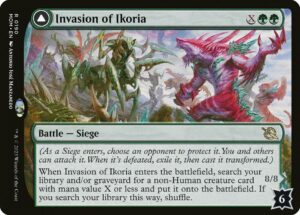
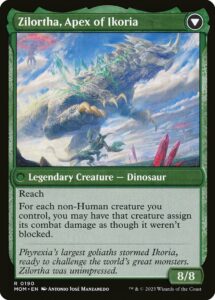
2: Invasion of Ikoria
The Finale of Devastation without the 10+ bonus here is pretty good by itself in Commander, since large singleton decks value tutors so highly. This doesn’t double as a finisher itself the way that Finale of Devastation does, except that casting this for x=8 and finding Craterhoof Behemoth is usually close enough. When you play it for smaller numbers, you have almost the same effect (except that you can’t find humans), but you also get the ability to attack with 6 power to get a meaningful threat.
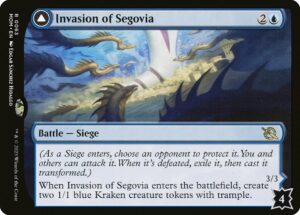
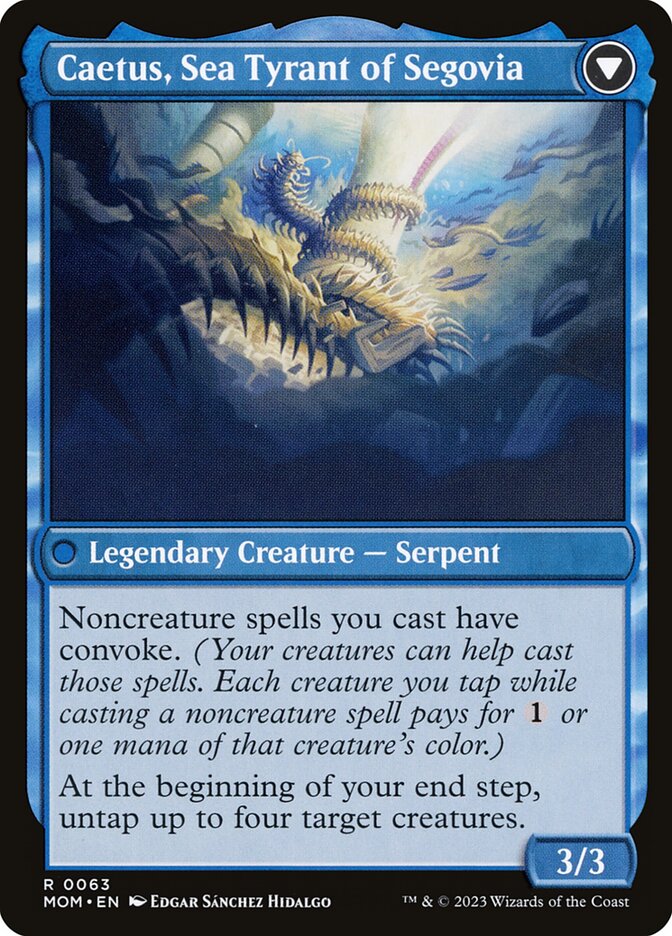
1: Invasion of Segovia
Three objects for three mana is respectable, almost no matter what the objects are. But here, one of the objects is worth way more than three mana–as soon as you transform Invasion of Segovia it typically gives you far more than three mana immediately. Between being able to use all your creatures as mana sources and untapping four each turn, this nets incredible amounts of mana each turn it’s alive. It’s easy to defeat, but even if you can’t defeat it, the upfront rate of two creatures for three mana isn’t bad in a tokens strategy. Any blue deck with a decent mix of creatures and instants should probably try to play this card.
I think there are several serviceable two mana battles which are fine to play, but are relatively low impact. One or both sides don’t give you a kind of effect typically valued in Commander, but some of these cards are really exciting. I expect battles will be very popular in Commander in the future, presuming new battles are regularly printed.
Sam Black (any) is a former professional Magic player, longtime Magic writer, host of the Drafting Archetypes podcast, and Twitch streamer. Sam is also a Commander Cube enthusiast, and you can find Sam’s cube list here. For anything else, find Sam on Twitter: @SamuelHBlack.

